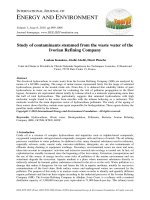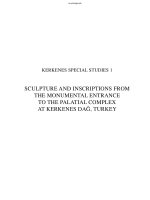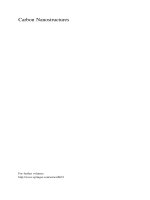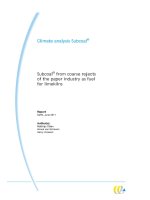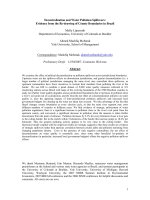- Trang chủ >>
- Khoa Học Tự Nhiên >>
- Vật lý
from the end of the rainbow to the edge of time ajourney through the wonders of physics FOR THE LOVE OF PHYSICS
Bạn đang xem bản rút gọn của tài liệu. Xem và tải ngay bản đầy đủ của tài liệu tại đây (2.39 MB, 214 trang )
Praisefor
FortheLoveofPhysics
“Fascinating....Adelightfulscientificmemoircombinedwithamemorableintroductiontophysics.”
—KirkusReviews
“MIT’s Lewin is deservedly popular for his memorable physics lectures (both live and on MIT’s
OpenCourseWarewebsiteandYouTube),andthisquick-pacedautobiography-cum-physicsintrofully
captures his candor and lively teaching style . . . joyful . . . [this text] glows with energy and should
pleaseawiderangeofreaders.”
—PublishersWeekly(starredreview)
“Lewin may be the only physics professor in the world who celebrates the beauty of Maxwell’s
equationsforelectromagneticfieldsbypassingoutflowerstohisdelightedstudents.Asthehundreds
ofthousandsofstudentswhohavewitnessedhislecturesinpersonoronlinecanattest,thisclassroom
wizardtransformstextbookformulasintomagic.Lewin’srarecreativityshinesthrough...apassportto
adventure.”
—Booklist(starredreview)
“OfallthesoulsmadefamousbyYouTube—JustinBieber,thoseweddingentrancedancers,thatguy
who loses his mind while videotaping a double-rainbow—none is more deserving than MIT physics
professorWalterLewin.Theprofessor’ssenseofwonderisonfulldisplayinanewbook:FortheLove
ofPhysics:FromtheEndoftheRainbowtotheEdgeofTime—AJourneyThroughtheWondersofPhysics.
Whyisarainbowanarcandnotastraightline?Whycanwetypicallyseeaurorasonlyifwe’recloseto
the North or South Pole? If you’ve ever been interested in learning— or relearning—the answers to
theseandahundredotherfascinatingquestions,Lewin’sbookisforyou.”
—TheBostonGlobe
“Everyoneknowsthatrainbowsappearafterastorm.Butinhisnewbook,Lewinrevealsnature’smore
unusualrainbowshidinginspraykickedupbyoceanwaves,infogswirlingaroundheadlights,evenin
glassparticlesfloatingaboveconstructionsites.Aftermorethanthirtyyearsofteachingundergraduate
physicsatMIT,Lewinhashonedatoolboxofclear,engagingexplanationsthatpresentphysicsasaway
of uncovering the world’s hidden wonders. Quirky, playful, and brimming with earnestness, each
chapterisajoyfulsketchofatopic—fromNewton’slawstoLewin’sownpioneeringdiscoveriesinX-ray
astronomy.Lewin’screativityofferslessonsbothforstudentsandforeducators....Throughoutitall,
hissenseofwonderisinfectious.”
—ScienceNews
“Walter Lewin’s unabashed passion for physics shines through on every page of this colorful, largely
autobiographicaltourofscience.Theexcitementofdiscoveryisinfectious.”
—MarioLivio,authorofTheGoldenRatioandIsGodaMathematician?
“In this fun, engaging, and accessible book, Walter Lewin, a superhero of the classroom, uses his
powersforgood—ours!Theauthorssharethejoyoflearningthattheworldisaknowableplace.”
—JamesKakalios,professorandauthorofThePhysicsofSuperheroesandTheAmazingStoryof
QuantumMechanics
FreePress
ADivisionofSimon&Schuster,Inc.1230AvenueoftheAmericas
NewYork,NY10020
www.SimonandSchuster.com
Copyright©2011byWalterLewinandWarrenGoldstein
Allrightsreserved,includingtherighttoreproducethisbookorportionsthereofinanyformwhatsoever.ForinformationaddressFree
PressSubsidiaryRightsDepartment,1230AvenueoftheAmericas,NewYork,NY10020.
FirstFreePresshardcovereditionMay2011
FREEPRESSandcolophonaretrademarksofSimon&Schuster,Inc.
TheSimon&SchusterSpeakersBureaucanbringauthorstoyourliveevent.FormoreinformationortobookaneventcontacttheSimon
&SchusterSpeakersBureauat1-866-248-3049orvisitourwebsiteatwww.simonspeakers.com.
BookdesignbyEllenR.Sasahara
ManufacturedintheUnitedStatesofAmerica
13579108642
LibraryofCongressCataloging-in-PublicationData
Lewin,WalterH.G.
Fortheloveofphysics:fromtheendoftherainbowtotheedgeoftime—ajourneythroughthewondersofphysics/byWalterLewinwith
WarrenGoldstein.
p.cm.
1.Lewin,WalterH.G.2.Physicists—Massachusetts—Biography.3.Collegeteachers—Massachusetts—Biography.4.Physics—Studyand
teaching—Netherlands.5.Physics—Studyandteaching—Massachusetts.I.Goldstein,WarrenJay.II.Title.
QC16.L485A32011
530.092—dc22
[B]2010047737
ISBN978-1-4391-0827-7
ISBN978-1-4391-2354-6(ebook)
Forallwhoinspiredmyloveforphysicsandart
—Walterlewin
FormygrandsonCalebBenjaminLuria
—WarrenGoldstein
CONTENTS
Introduction
1.FromtheNucleustoDeepSpace
2.Measurements,Uncertainties,andtheStars
3.BodiesinMotion
4.TheMagicofDrinkingwithaStraw
5.OverandUnder—OutsideandInside—theRainbow
6.TheHarmoniesofStringsandWinds
7.TheWondersofElectricity
8.TheMysteriesofMagnetism
9.EnergyConservation—Plusçachange…
10.X-raysfromOuterSpace!
11.X-rayBallooning,theEarlyDays
12.CosmicCatastrophes,NeutronStars,andBlackHoles
13.CelestialBallet
14.X-rayBursters!
15.WaysofSeeing
Acknowledgments
Appendix1
Appendix2
Index
INTRODUCTION
Six feet two and lean, wearing what looks like a blue work shirt, sleeves rolled to the elbows, khaki
cargopants,sandalsandwhitesocks,theprofessorstridesbackandforthatthefrontofhislecturehall,
declaiming, gesturing, occasionally stopping for emphasis between a long series of blackboards and a
thigh-highlabtable.Fourhundredchairsslopeupwardinfrontofhim,occupiedbystudentswhoshift
in their seats but keep their eyes glued to their professor, who gives the impression that he is barely
containingsomepowerfulenergycoursingthroughhisbody.Withhishighforehead,shockofunruly
grey hair, glasses, and the trace of some unidentifiable European accent, he gives off a hint of
Christopher Lloyd’s Doc Brown in the movie Back to the Future—the intense, otherworldly, slightly
madscientist-inventor.
But this is not Doc Brown’s garage—it’s the Massachusetts Institute of Technology, the preeminent
science and engineering university in the United States, perhaps even the world, and lecturing at the
blackboard is Professor Walter H. G. Lewin. He halts his stride and turns to the class. “Now. All
importantinmakingmeasurements,whichisalwaysignoredineverycollegephysicsbook”—hethrows
his arms wide, fingers spread—“is the uncertainty in your measurements.” He pauses, takes a step,
givingthemtimetoconsider,andstopsagain:“Anymeasurementthatyoumakewithoutknowledgeof
theuncertaintyismeaningless.”Andthehandsflyapart,choppingtheairforemphasis.Anotherpause.
“Iwillrepeatthis.Iwantyoutohearittonightatthreeo’clockinthemorningwhenyouwakeup.”
Heisholdingbothindexfingerstohistemples,twistingthem,pretendingtoboreintohisbrain.“Any
measurement that you make without knowledge of its uncertainty is completely meaningless.” The
studentsstareathim,utterlyrapt.
We’re just eleven minutes into the first class of Physics 8.01, the most famous introductory college
physicscourseintheworld.
The New York Times ran a front-page piece on Walter Lewin as an MIT “webstar” in December
2007,featuringhisphysicslecturesavailableontheMITOpenCourseWaresite,aswellasonYouTube,
iTunesU,andAcademicEarth.Lewin’swereamongthefirstlecturesthatMITpostedontheInternet,
anditpaidoffforMIT.Theyhavebeenexceptionallypopular.Theninety-fourlectures—inthreefull
courses, plus seven stand-alones—garner about three thousand viewers per day, a million hits a year.
Those include quite a few visits from none other than Bill Gates, who’s watched all of courses 8.01,
Classical Mechanics, and 8.02, Electricity and Magnetism, according to letters (snail mail!) he’s sent
Walter,reportingthathewaslookingforwardtomovingonto8.03,VibrationsandWaves.
“Youhavechangedmylife,”runsacommonsubjectlineintheemailsLewinreceiveseverydayfrom
peopleofallagesandfromallovertheworld.Steve,afloristfromSanDiego,wrote,“Iwalkwithanew
spring in my step and I look at life through physics-colored eyes.” Mohamed, an engineering prep
schoolstudentinTunisiawrote,“Unfortunately,hereinmycountrymyprofessorsdon’tseeanybeauty
in physics as you do see, and I’ve suffered a lot from this. They just want us to learn how to solve
‘typical’exercisestosucceedintheexam,theydon’tlookbeyondthattinyhorizon.”Seyed,anIranian
whohadalreadyearnedacoupleofAmericanmaster’sdegrees,writes,“Ineverreallyenjoyoflifeuntil
I have watched you teach physics. Professor Lewin you have changed my life Indeed. The way you
teachitisworth10timesthetuition,andmakeSOMEnotallotherteachersbunchofcriminals.Itis
CAPITAL CRIME to teach bad.” Or Siddharth from India: “I could feel Physics beyond those
equations.YourstudentswillalwaysrememberyouasIwillalwaysrememberyou—asavery-veryfine
teacherwhomadelifeandlearningmoreinterestingthanIthoughtwaspossible.”
Mohamed enthusiastically quotes Lewin’s final lecture in Physics 8.01 with approval: “Perhaps you
will always remember from my lectures that physics can be very exciting and beautiful and it’s
everywhere around us, all the time, if only you have learned to see it and appreciate its beauty.”
Marjory, another fan, wrote, “I watch you as often as I can; sometimes five times per week. I am
fascinatedbyyourpersonality,yoursenseofhumor,andaboveallbyyourabilitytosimplifymatters.I
hatedphysicsinhighschool,butyoumademeloveit.”
Lewinreceivesdozensofsuchemailseveryweek,andheanswerseachone.
Walter Lewin creates magic when he introduces the wonders of physics. What’s his secret? “I
introducepeopletotheirownworld,”hesays,“theworldtheyliveinandarefamiliarwith,butdon’t
approachlikeaphysicist—yet.IfItalkaboutwavesonwater,Iaskthemtodocertainexperimentsin
theirbathtubs;theycanrelatetothat.Theycanrelatetorainbows.That’soneofthethingsIloveabout
physics:yougettoexplainanything.Andthatcanbeawonderfulexperience—forthemandforme.I
makethemlovephysics!Sometimes,whenmystudentsgetreallyengaged,theclassesalmostfeellike
happenings.”
Hemightbeperchedatthetopofasixteen-footladdersuckingcranberryjuiceoutofabeakeronthe
floor with a long snaking straw made out of lab tubing. Or he could be courting serious injury by
putting his head in the path of a small but quite powerful wrecking ball that swings to within
millimeters of his chin. He might be firing a rifle into two paint cans filled with water, or charging
himselfwith300,000voltsofelectricitywithalargecontraptioncalledaVandeGraaffgenerator—like
something out of a mad scientist’s laboratory in a science fiction movie—so that his already wild hair
stands straight out from his skull. He uses his body as a piece of experimental equipment. As he says
often,“Sciencerequiressacrifices,afterall.”Inonedemonstration—capturedinthephotoonthejacket
ofthisbook—hesitsonanextremelyuncomfortablemetalballattheendofaropesuspendedfromthe
lecturehall’sceiling(whathecallsthemotherofallpendulums)andswingsbackandforthwhilehis
studentschantthenumberofswings,alltoprovethatthenumberofswingsapendulummakesinany
giventimeisindependentoftheweightatitsend.
Hisson,Emanuel(Chuck)Lewin,hasattendedsomeoftheselecturesandrecounts,“Isawhimonce
inhaleheliumtochangehisvoice.Togettheeffectright—thedevilisinthedetails—hetypicallygets
pretty close to the point of fainting.” An accomplished artist of the blackboard, Lewin draws
geometricalfigures,vectors,graphs,astronomicalphenomena,andanimalswithabandon.Hismethod
ofdrawingdottedlinessoentrancedseveralstudentsthattheyproducedafunnyYouTubevideotitled
“SomeofWalterLewin’sBestLines,”consistingsimplyoflectureexcerptsshowingLewindrawinghis
famous dotted lines on different blackboards during his 8.01 lectures. (You can watch it here:
www.youtube.com/watch?v=raurl4s0pjU.)
Acommanding,charismaticpresence,Lewinisagenuineeccentric:quirkyandphysicsobsessed.He
carriestwodevicescalledpolarizersinhiswalletatalltimes,sothatatamoment’snoticehecanseeif
any source of light, such as the blue sky, a rainbow, or reflections off windows, is polarized, and
whoeverhemightbewithcanseeittoo.
Whataboutthoseblueworkshirtshewearstoclass?Notworkshirtsatall,itturnsout.Lewinorders
them,custommadetohisspecifications,ofhigh-gradecotton,adozenatatimeeveryfewyears,froma
tailorinHongKong.TheoversizepocketontheleftsideLewindesignedtoaccommodatehiscalendar.
No pocket protectors here—this physicist-performer-teacher is a man of meticulous fashion—which
makes a person wonder why he appears to be wearing the oddest brooch ever worn by a university
professor:aplasticfriedegg.“Better,”hesays,“tohaveeggonmyshirtthanonmyface.”
WhatisthatoversizepinkLuciteringdoingonhislefthand?Andwhatisthatsilverythingpinching
hisshirtrightatbelly-buttonlevel,whichhekeepssneakinglooksat?
EverymorningasLewindresses,hehasthechoiceoffortyringsandthirty-fivebrooches,aswellas
dozensofbraceletsandnecklaces.Histasterunsfromtheeclectic(Kenyanbeadedbracelets,anecklace
of large amber pieces, plastic fruit brooches) to the antique (a heavy silver Turkmen cuff bracelet) to
designerandartist-createdjewelry,tothesimplyandhilariouslyoutrageous(anecklaceoffeltlicorice
candies). “The students started noticing,” he says, “so I began wearing a different piece every lecture.
AndespeciallywhenIgivetalkstokids.Theyloveit.”
Andthatthingclippedtohisshirtthatlookslikeanoversizetieclip?It’saspeciallydesignedwatch
(thegiftofanartistfriend)withthefaceupsidedown,soLewincanlookdownathisshirtandkeep
trackoftime.
ItsometimesseemstoothersthatLewinisdistracted,perhapsaclassicabsentmindedprofessor.But
in reality, he is usually deeply engaged in thinking about some aspect of physics. As his wife Susan
Kaufmanrecentlyrecalled,“WhenwegotoNewYorkIalwaysdrive.ButrecentlyItookthismapout,
I’m not sure why, but when I did I noticed there were equations all over the margins of the states.
Thosemarginsweredonewhenhewaslastlecturing,andhewasboredwhenweweredriving.Physics
wasalwaysonhismind.Hisstudentsandschoolwerewithhimtwenty-fourhoursaday.”
Perhaps most striking of all about Lewin’s personality, according to his longtime friend the
architecturalhistorianNancyStieber,is“thelaser-sharpintensityofhisinterest.Heseemsalwaystobe
maximallyengagedinwhateverhechoosestobeinvolvedin,andeliminates90percentoftheworld.
Withthatlaserlikefocus,heeliminateswhat’sinessentialtohim,gettingtoaformofengagementthat
issointense,itproducesaremarkablejoiedevivre.”
Lewinisaperfectionist;hehasanalmostfanaticalobsessionwithdetail.Heisnotonlytheworld’s
premier physics teacher; he was also a pioneer in the field of X-ray astronomy, and he spent two
decades building, testing, and observing subatomic and astronomical phenomena with ultrasensitive
equipmentdesignedtomeasureX-raystoaremarkabledegreeofaccuracy.Launchingenormousand
extremely delicate balloons that skimmed the upper limit of Earth’s atmosphere, he began to uncover
an exotic menagerie of astronomical phenomena, such as X-ray bursters. The discoveries he and his
colleaguesinthefieldmadehelpedtodemystifythenatureofthedeathofstarsinmassivesupernova
explosionsandtoverifythatblackholesreallydoexist.
He learned to test, and test, and test again—which not only accounts for his success as an
observational astrophysicist, but also for the remarkable clarity he brings to revealing the majesty of
Newton’s laws, why the strings of a violin produce such beautifully resonant notes, and why you lose
andgainweight,beitonlyverybriefly,whenyourideinanelevator.
Forhislectures,healwayspracticedatleastthreetimesinanemptyclassroom,withthelastrehearsal
beingatfivea.m.onlectureday.“Whatmakeshislectureswork,”saysastrophysicistDavidPooley,a
formerstudentwhoworkedwithhimintheclassroom,“isthetimeheputsintothem.”
When MIT’s Physics Department nominated Lewin for a prestigious teaching award in 2002, a
numberofhiscolleagueszeroedinontheseexactqualities.Oneofthemostevocativedescriptionsof
the experience of learning physics from Lewin is from Steven Leeb, now a professor of electrical
engineering and computer science at MIT’s Laboratory for Electromagnetic and Electronic Systems,
who took his Electricity and Magnetism course in 1984. “He exploded onto the stage,” Leeb recalls,
“seizedusbythebrains,andtookoffonaroller-coasterrideofelectromagneticsthatIcanstillfeelon
the back of my neck. He is a genius in the classroom with an unmatched resourcefulness for finding
waystomakeconceptsplain.”
RobertHulsizer,oneofLewin’sPhysicsDepartmentcolleagues,triedtoexcerptsomeofLewin’sinclassdemonstrationsonvideotomakeakindofhighlightfilmforotheruniversities.Hefoundthetask
impossible. “The demonstrations were so well woven into the development of the ideas, including a
buildup and denouement, that there was no clear time when the demonstration started and when it
finished.Tomymind,Walterhadarichnessofpresentationthatcouldnotbeslicedintobites.”
The thrill of Walter Lewin’s approach to introducing the wonders of physics is the great joy he
conveys about all the wonders of our world. His son Chuck fondly recalls his father’s devotion to
impartingthatsenseofjoytohimandhissiblings:“Hehasthisabilitytogetyoutoseethingsandtobe
overwhelmedbyhowbeautifultheyare,tostirthepotinyouofjoyandamazementandexcitement.
I’mtalkingaboutlittleunbelievablewindowshewasatthecenterof,youfeltsohappytobealive,in
hispresence,inthiseventthathecreated.WewereonvacationinMaineonce.Itwasn’tgreatweather,
Irecall,andwekidswerejusthangingout,thewaykidsdo,bored.Somehowmyfathergotalittleball
andspontaneouslycreatedthisstrangelittlegame,andinaminutesomeoftheotherbeachkidsfrom
nextdoorcameover,andsuddenlytherewerefour,five,sixofusthrowing,catching,andlaughing.I
rememberbeingsoutterlyexcitedandjoyful.IfIlookbackandthinkaboutwhat’smotivatedmeinmy
life,havingthosemomentsofpurejoy,havingavisionofhowgoodlifecanbe,asenseofwhatlifecan
hold—I’vegottenthatfrommyfather.”
Walterusedtoorganizehischildrentoplayagameinthewinter,testingtheaerodynamicqualityof
paper airplanes—by flying them into the family’s big open living room fireplace. “To my mother’s
horror,” Chuck recalled, “we would recover them from the fire—we were determined to win the
competitionthenexttimeround!”
Whenguestscamefordinner,WalterwouldpresideoverthegameofGoingtotheMoon.AsChuck
remembersit,“Wewoulddimthelights,poundourfistsonthetablemakingadrumrollkindofsound,
simulating the noise of a rocket launch. Some of the kids would even go under the table and pound.
Then, as we reached space, we stopped the pounding, and once we landed on the Moon, all of us
wouldwalkaroundthelivingroompretendingtobeinverylowgravity,takingcrazyexaggeratedsteps.
Meanwhile, the guests must have been thinking, ‘These people are nuts!’ But for us kids, it was
fantastic!GoingtotheMoon!”
WalterLewinhasbeentakingstudentstotheMoonsincehefirstwalkedintoaclassroommorethan
a half century ago. Perpetually entranced by the mystery and beauty of the natural world—from
rainbows to neutron stars, from the femur of a mouse to the sounds of music—and by the efforts of
scientists and artists to explain, interpret, and represent this world, Walter Lewin is one of the most
passionate, devoted, and skillful scientific guides to that world now alive. In the chapters that follow
youwillbeabletoexperiencethatpassion,devotion,andskillasheuncovershislifelongloveofphysics
andsharesitwithyou.Enjoythejourney!
—WarrenGoldstein
CHAPTER1
FromtheNucleustoDeepSpace
It’s amazing, really. My mother’s father was illiterate, a custodian. Two generations later I’m a full
professoratMIT.IowealottotheDutcheducationalsystem.IwenttograduateschoolattheDelft
UniversityofTechnologyintheNetherlands,andkilledthreebirdswithonestone.
Right from the start, I began teaching physics. To pay for school I had to take out a loan from the
Dutch government, and if I taught full time, at least twenty hours a week, each year the government
wouldforgiveone-fifthofmyloan.AnotheradvantageofteachingwasthatIwouldn’thavetoservein
thearmy.Themilitarywouldhavebeentheworst,anabsolutedisasterforme.I’mallergictoallforms
of authority—it’s just in my personality—and I knew I would have ended up mouthing off and
scrubbing floors. So I taught math and physics full time, twenty-two contact hours per week, at the
LibanonLyceuminRotterdam,tosixteen-andseventeen-year-olds.Iavoidedthearmy,didnothaveto
paybackmyloan,andwasgettingmyPhD,allatthesametime.
I also learned to teach. For me, teaching high school students, being able to change the minds of
youngpeopleinapositiveway,thatwasthrilling.Ialwaystriedtomakeclassesinterestingbutalsofun
for the students, even though the school itself was quite strict. The classroom doors had transom
windows at the top, and one of the headmasters would sometimes climb up on a chair and spy on
teachersthroughthetransom.Canyoubelieveit?
I wasn’t caught up in the school culture, and being in graduate school, I was boiling over with
enthusiasm.Mygoalwastoimpartthatenthusiasmtomystudents,tohelpthemseethebeautyofthe
world all around them in a new way, to change them so that they would see the world of physics as
beautiful,andwouldunderstandthatphysicsiseverywhere,thatitpermeatesourlives.Whatcounts,I
found, is not what you cover, but what you uncover. Covering subjects in a class can be a boring
exercise, and students feel it. Uncovering the laws of physics and making them see through the
equations, on the other hand, demonstrates the process of discovery, with all its newness and
excitement,andstudentslovebeingpartofit.
Igottodothisalsoinadifferentwayfaroutsidetheclassroom.Everyyeartheschoolsponsoreda
week-long vacation when a teacher would take the kids on a trip to a fairly remote and primitive
campsite.Mywife,Huibertha,andIdiditonceandlovedit.Weallcookedtogetherandsleptintents.
Then, since we were so far from city lights, we woke all the kids up in the middle of one night, gave
them hot chocolate, and took them out to look at the stars. We identified constellations and planets
andtheygottoseetheMilkyWayinitsfullglory.
Iwasn’tstudyingoreventeachingastrophysics—infact,Iwasdesigningexperimentstodetectsome
ofthesmallestparticlesintheuniverse—butI’dalwaysbeenfascinatedbyastronomy.Thetruthisthat
justabouteveryphysicistwhowalkstheEarthhasaloveforastronomy.ManyphysicistsIknowbuilt
their own telescopes when they were in high school. My longtime friend and MIT colleague George
Clark ground and polished a 6-inch mirror for a telescope when he was in high school. Why do
physicists love astronomy so much? For one thing, many advances in physics—theories of orbital
motion,forinstance—haveresultedfromastronomicalquestions,observations,andtheories.Butalso,
astronomyis physics, writ large across the night sky: eclipses, comets, shooting stars, globular clusters,
neutronstars,gamma-raybursts,jets,planetarynebulae,supernovae,clustersofgalaxies,blackholes.
Justlookupintheskyandaskyourselfsomeobviousquestions:Whyistheskyblue,whyaresunsets
red,whyarecloudswhite?Physicshastheanswers!ThelightoftheSuniscomposedofallthecolorsof
therainbow.Butasitmakesitswaythroughtheatmosphereitscattersinalldirectionsoffairmolecules
andverytinydustparticles(muchsmallerthanamicron,whichis1/250,000ofaninch).Thisiscalled
Rayleighscattering.Bluelightscattersthemostofallcolors,aboutfivetimesmorethanredlight.Thus
when you look at the sky during the day in any direction*, blue dominates, which is why the sky is
blue.IfyoulookattheskyfromthesurfaceoftheMoon(youmayhaveseenpictures),theskyisnot
blue—it’sblack,likeourskyatnight.Why?BecausetheMoonhasnoatmosphere.
Why are sunsets red? For exactly the same reason that the sky is blue. When the Sun is at the
horizon, its rays have to travel through more atmosphere, and the green, blue, and violet light get
scatteredthemost—filteredoutofthelight,basically.Bythetimethelightreachesoureyes—andthe
clouds above us—it’s made up largely of yellow, orange, and especially red. That’s why the sky
sometimesalmostappearstobeonfireatsunsetandsunrise.
Whyarecloudswhite?Thewaterdropsincloudsaremuchlargerthanthetinyparticlesthatmake
ourskyblue,andwhenlightscattersoffthesemuchlargerparticles,allthecolorsinitscatterequally.
Thiscausesthelighttostaywhite.Butifacloudisverythickwithmoisture,orifitisintheshadowof
anothercloud,thennotmuchlightwillgetthrough,andthecloudwillturndark.
OneofthedemonstrationsIlovetodoistocreateapatchof“bluesky”inmyclasses.Iturnallthe
lights off and aim a very bright spotlight of white light at the ceiling of the classroom near my
blackboard.Thespotlightiscarefullyshielded.ThenIlightafewcigarettesandholdtheminthelight
beam. The smoke particles are small enough to produce Rayleigh scattering, and because blue light
scatters the most, the students see blue smoke. I then carry this demonstration one step further. I
inhale the smoke and keep it in my lungs for a minute or so—this is not always easy, but science
occasionally requires sacrifices. I then let go and exhale the smoke into the light beam. The students
nowseewhitesmoke—Ihavecreatedawhitecloud!Thetinysmokeparticleshavegrowninmylungs,
as there is a lot of water vapor there. So now all the colors scatter equally, and the scattered light is
white.Thecolorchangefrombluelighttowhitelightistrulyamazing!
Withthisdemonstration,I’mabletoanswertwoquestionsatonce:Whyistheskyblue,andwhyare
cloudswhite?Actually,thereisalsoathirdveryinterestingquestion,havingtodowiththepolarization
oflight.I’llgettothisinchapter5.
Out in the country with my students I could show them the Andromeda galaxy, the only one you
canseewiththenakedeye,around2.5millionlight-yearsaway(15milliontrillionmiles),whichisnext
door as far as astronomical distances go. It’s made up of about 200 billion stars. Imagine that—200
billionstars,andwecouldjustmakeitoutasafaintfuzzypatch.Wealsospottedlotsofmeteorites—
most people call them shooting stars. If you were patient, you’d see one about every four or five
minutes. In those days there were no satellites, but now you’d see a host of those as well. There are
more than two thousand now orbiting Earth, and if you can hold your gaze for five minutes you’ll
almostsurelyseeone,especiallywithinafewhoursaftersunsetorbeforesunrise,whentheSunhasn’t
yetsetorrisenonthesatelliteitselfandsunlightstillreflectsoffittoyoureyes.Themoredistantthe
satellite,andthereforethegreaterthedifferenceintimebetweensunsetonEarthandatthesatellite,
thelateryoucanseeitatnight.Yourecognizesatellitesbecausetheymovefasterthananythingelsein
thesky(exceptmeteors);ifitblinks,believeme,it’sanairplane.
I have always especially liked to point out Mercury to people when we’re stargazing. As the planet
closesttotheSun,it’sverydifficulttoseeitwiththenakedeye.Theconditionsarebestonlyabouttwo
dozeneveningsandmorningsayear.MercuryorbitstheSuninjusteighty-eightdays,whichiswhyit
wasnamedforthefleet-footedRomanmessengergod;andthereasonit’ssohardtoseeisthatitsorbit
issoclosetotheSun.It’snevermorethanabout25degreesawayfromtheSunwhenwelookatitfrom
Earth—that’ssmallerthantheanglebetweenthetwohandsofawatchateleveno’clock.Youcanonly
seeitshortlyaftersunsetandbeforesunrise,andwhenit’sfarthestfromtheSunasseenfromEarth.In
the United States it’s always close to the horizon; you almost have to be in the countryside to see it.
Howwonderfulitiswhenyouactuallyfindit!
Stargazingconnectsustothevastnessoftheuniverse.Ifwekeepstaringupatthenightsky,andlet
our eyes adjust long enough, we can see the superstructure of the farther reaches of our own Milky
Way galaxy quite beautifully—some 100 billion to 200 billion stars, clustered as if woven into a
diaphanous fabric, so delightfully delicate. The size of the universe is incomprehensible, but you can
begintograspitbyfirstconsideringtheMilkyWay.
Ourcurrentestimateisthattheremaybeasmanygalaxiesintheuniverseastherearestarsinour
own galaxy. In fact, whenever a telescope observes deep space, what it sees is mostly galaxies—it’s
impossible to distinguish single stars at truly great distances—and each contains billions of stars. Or
consider the recent discovery of the single largest structure in the known universe, the Great Wall of
galaxies,mappedbytheSloanDigitalSkySurvey,amajorprojectthathascombinedtheeffortsofmore
than three hundred astronomers and engineers and twenty-five universities and research institutions.
ThededicatedSloantelescopeisobservingeverynight;itwentintooperationintheyear2000andwill
continuetillatleasttheyear2014.TheGreatWallismorethanabillionlight-yearslong.Isyourhead
spinning? If not, then consider that the observable universe (not the entire universe, just the part we
canobserve)isroughly90billionlight-yearsacross.
Thisisthepowerofphysics;itcantellusthatourobservableuniverseismadeupofsome100billion
galaxies.Itcanalsotellusthatofallthematterinourvisibleuniverse,onlyabout4percentisordinary
matter, of which stars and galaxies (and you and I) are made. About 23 percent is what’s called dark
matter(it’sinvisible).Weknowitexists,butwedon’tknowwhatitis.Theremaining73percent,which
isthebulkoftheenergyinouruniverse,iscalleddarkenergy,whichisalsoinvisible.Noonehasaclue
whatthatiseither.Thebottomlineisthatwe’reignorantabout96percentofthemass/energyinour
universe. Physics has explained so much, but we still have many mysteries to solve, which I find very
inspiring.
Physicsexploresunimaginableimmensity,butatthesametimeitcandigdownintotheverysmallest
realms,totheverybitsofmattersuchasneutrinos,assmallasatinyfractionofaproton.Thatiswhere
Iwasspendingmostofmytimeinmyearlydaysinthefield,intherealmsoftheverysmall,measuring
and mapping the release of particles and radiation from radioactive nuclei. This was nuclear physics,
butnotthebomb-makingvariety.Iwasstudyingwhatmademattertickatareallybasiclevel.
Youprobablyknowthatalmostallthematteryoucanseeandtouchismadeupofelements,suchas
hydrogen,oxygen,andcarboncombinedintomolecules,andthatthesmallestunitofanelementisan
atom, made up of a nucleus and electrons. A nucleus, recall, consists of protons and neutrons. The
lightest and most plentiful element in the universe, hydrogen, has one proton and one electron. But
thereisaformofhydrogenthathasaneutronaswellasaprotoninitsnucleus.Thatisanisotopeof
hydrogen, a different form of the same element; it’s called deuterium. There’s even a third isotope of
hydrogen, with two neutrons joining the proton in the nucleus; that’s called tritium. All isotopes of a
given element have the same number of protons, but a different number of neutrons, and elements
have different numbers of isotopes. There are thirteen isotopes of oxygen, for instance, and thirty-six
isotopesofgold.
Now, many of these isotopes are stable—that is, they can last more or less forever. But most are
unstable,whichisanotherwayofsayingthey’reradioactive, and radioactive isotopes decay: that is to
say, sooner or later they transform themselves into other elements. Some of the elements they
transform into are stable, and then the radioactive decay stops, but others are unstable, and then the
decaycontinuesuntilastablestateisreached.Ofthethreeisotopesofhydrogen,onlyone,tritium,is
radioactive—it decays into a stable isotope of helium. Of the thirteen isotopes of oxygen, three are
stable;ofgold’sthirty-sixisotopes,onlyoneisstable.
Youwillprobablyrememberthatwemeasurehowquicklyradioactiveisotopesdecaybytheir“halflife”—which can range from a microsecond (one-millionth of a second) to billions of years. If we say
thattritiumhasahalf-lifeofabouttwelveyears,wemeanthatinagivensampleoftritium,halfofthe
isotopes will decay in twelve years (only one-quarter will remain after twenty-four years). Nuclear
decay is one of the most important processes by which many different elements are transformed and
created. It’s not alchemy. In fact, during my PhD research, I was often watching radioactive gold
isotopesdecayintomercuryratherthantheotherwayaround,asthemedievalalchemistswouldhave
liked. There are, however, many isotopes of mercury, and also of platinum, that decay into gold. But
onlyoneplatinumisotopeandonlyonemercuryisotopedecayintostablegold,thekindyoucanwear
onyourfinger.
Theworkwasimmenselyexciting;Iwouldhaveradioactiveisotopesliterallydecayinginmyhands.
Anditwasveryintense.TheisotopesIwasworkingwithtypicallyhadhalf-livesofonlyadayorafew
days.Gold-198,forinstance,hasahalf-lifeofalittleovertwoandahalfdays,soIhadtoworkfast.I
woulddrivefromDelfttoAmsterdam,wheretheyusedacyclotrontomaketheseisotopes,andrush
backtothelabatDelft.ThereIwoulddissolvetheisotopesinanacidtogetthemintoliquidform,put
themonverythinfilm,andplacethemintodetectors.
I was trying to verify a theory about nuclear decay, one that predicted the ratio of gamma ray to
electron emissions from the nuclei, and my work required precise measurements. This work had
already been done for many radioactive isotopes, but some recent measurements had come out that
weredifferentfromwhatthetheorypredicted.Mysupervisor,ProfessorAaldertWapstra,suggestedI
trytodeterminewhetheritwasthetheoryorthemeasurementsthatwereatfault.Itwasenormously
satisfying,likeworkingonafantasticallyintricatepuzzle.Thechallengewasthatmymeasurementshad
tobemuchmoreprecisethantheonesthoseotherresearchershadcomeupwithbeforeme.
Electrons are so small that some say they have no effective size—they’re less than a thousandtrillionth of a centimeter across—and gamma rays have a wavelength of less than a billionth of a
centimeter.Andyetphysicshadprovidedmewiththemeanstodetectandtocountthem.That’syet
anotherthingthatIloveaboutexperimentalphysics;itletsus“touch”theinvisible.
To get the measurements I needed, I had to milk the sample as long as I could, because the more
countsIhad,thegreatermyprecisionwouldbe.I’dfrequentlybeworkingforsomethinglike60hours
straight,oftenwithoutsleeping.Ibecamealittleobsessed.
For an experimental physicist, precision is key in everything. The accuracy is the only thing that
matters, and a measurement that doesn’t also indicate its degree of accuracy is meaningless. This
simple, powerful, totally fundamental idea is almost always ignored in college books about physics.
Knowingdegreesofaccuracyiscriticaltosomanythingsinourlives.
In my work with radioactive isotopes, attaining the degree of accuracy I had to achieve was very
challenging,butoverthreeorfouryearsIgotbetterandbetteratthemeasurements.AfterIimproved
some of the detectors, they turned out to be extremely accurate. I was confirming the theory, and
publishingmyresults,andthisworkendedupbeingmyPhDthesis.Whatwasespeciallysatisfyingto
mewasthatmyresultswereratherconclusive,whichdoesn’thappenveryoften.Manytimesinphysics,
andinsciencegenerally,resultsarenotalwaysclear-cut.Iwasfortunatetoarriveatafirmconclusion.I
had solved a puzzle and established myself as a physicist, and I had helped to chart the unknown
territory of the subatomic world. I was twenty-nine years old, and I was thrilled to be making a solid
contribution. Not all of us are destined to make gigantic fundamental discoveries like Newton and
Einsteindid,butthere’sanawfullotofterritorythatisstillripeforexploration.
IwasalsofortunatethatatthetimeIgotmydegree,awholeneweraofdiscoveryaboutthenature
oftheuniversewasgettingunderway.Astronomersweremakingdiscoveriesatanamazingpace.Some
wereexaminingtheatmospheresofMarsandVenus,searchingforwatervapor.Somehaddiscovered
thebeltsofchargedparticlescirclingtheEarth’smagneticfieldlines,whichwenowcalltheVanAllen
belts. Others had discovered huge, powerful sources of radio waves known as quasars (quasi-stellar
radiosources).Thecosmicmicrowavebackground(CMB)radiationwasdiscoveredin1965—thetraces
of the energy released by the big bang, powerful evidence for the big bang theory of the universe’s
origin,whichhadbeencontroversial.Shortlyafter,in1967,astronomerswoulddiscoveranewcategory
ofstars,whichcametobecalledpulsars.
I might have continued working in nuclear physics, as there was a great deal of discovery going on
thereaswell.Thisworkwasmostlyinthehuntforanddiscoveryofarapidlygrowingzooofsubatomic
particles,mostimportantlythosecalledquarks,whichturnedouttobethebuildingblocksofprotons
and neutrons. Quarks are so odd in their range of behaviors that in order to classify them, physicists
assigned them what they called flavors: up, down, strange, charm, top, and bottom. The discovery of
quarks was one of those beautiful moments in science when a purely theoretical idea is confirmed.
Theoristshadpredictedquarks,andthenexperimentalistsmanagedtofindthem.Andhowexoticthey
were,revealingthatmatterwassomuchmorecomplicatedinitsfoundationsthanwehadknown.For
instance, we now know that protons consist of two up quarks and one down quark, held together by
the strong nuclear force, in the form of other strange particles called gluons. Some theoreticians have
recently calculated that the up quark seems to have a mass of about 0.2 percent of that of a proton,
while the down quark has a mass of about 0.5 percent of the mass of a proton. This was not your
grandfather’snucleusanymore.The particle zoo would have been a fascinating area of research to go
into,I’msure,butbyahappyaccident,theskillsI’dlearnedformeasuringradiationemittedfromthe
nucleus turned out to be extremely useful for probing the universe. In 1965, I received an invitation
fromProfessorBrunoRossiatMITtoworkonX-rayastronomy,whichwasanentirelynewfield,really
justafewyearsoldatthetime—Rossihadinitiateditin1959.
MIT was the best thing that could ever have happened to me. Rossi’s work on cosmic rays was
already legendary. He’d headed a department at Los Alamos during the war and pioneered in the
measurementsofsolarwind,alsocalledinterplanetaryplasma—astreamofchargedparticlesejectedby
the Sun that causes our aurora borealis and “blows” comet tails away from the Sun. Now he had the
ideatosearchthecosmosforX-rays.Itwascompletelyexploratorywork;hehadnoideawhetherhe’d
findthemornot.
Anything went at that time at MIT. Any idea you had, if you could convince people that it was
doable, you could work on it. What a difference from the Netherlands! At Delft, there was a rigid
hierarchy,andthegraduatestudentsweretreatedlikealowerclass.Theprofessorsweregivenkeysto
the front door of my building, but as a graduate student you only got a key to the door in the
basement,wherethebicycleswerekept.Eachtimeyouenteredthebuildingyouhadtopickyourway
throughthebicyclestorageroomsandberemindedofthefactthatyouwerenothing.
Ifyouwantedtoworkafterfiveo’clockyouhadtofilloutaform,everyday,byfourp.m.,justifying
whyyouhadtostaylate,whichIhadtodoalmostallthetime.Thebureaucracywasarealnuisance.
The three professors in charge of my institute had reserved parking places close to the front door.
One of them, my own supervisor, worked in Amsterdam and came to Delft only once a week on
Tuesdays. I asked him one day, “When you are not here, would you mind if I used your parking
space?”Hesaid,“Ofcoursenot,”butthentheveryfirstdayIparkedthereIwascalledonthepublic
intercom and instructed in the strongest terms possible that I was to remove my car. Here’s another
one.SinceIhadtogotoAmsterdamtopickupmyisotopes,Iwasallowed25centsforacupofcoffee,
and1.25guildersforlunch(1.25guilderswasaboutone-thirdofaU.S.dollaratthetime),butIhadto
submitseparatereceiptsforeach.SoIaskedifIcouldaddthe25centstothelunchreceiptandonly
submit one receipt for 1.50 guilders. The department chair, Professor Blaisse, wrote me a letter that
statedthatifIwantedtohavegourmetmealsIcoulddoso—atmyownexpense.
SowhatajoyitwastogettoMITandbefreefromallofthat;Ifeltreborn.Everythingwasdoneto
encourageyou.IgotakeytothefrontdoorandcouldworkinmyofficedayornightjustasIwanted.
To me, that key to the building was like a key to everything. The head of the Physics Department
offeredmeafacultypositionsixmonthsaftermyarrival,inJuneof1966.IacceptedandI’veneverleft.
ArrivingatMITwasalsosoexhilaratingbecauseIhadlivedthroughthedevastationofWorldWar
II. The Nazis had murdered half of my family, a tragedy that I haven’t really digested yet. I do talk
aboutitsometimes,butveryrarelybecauseit’ssoverydifficultforme—itismorethansixty-fiveyears
ago,andit’sstilloverwhelming.WhenmysisterBeaandItalkaboutit,wealmostalwayscry.
I was born in 1936, and I was just four years old when the Germans attacked the Netherlands on
May10,1940.Oneofmyearliestmemoriesisallofus,mymother’sparents,mymotherandfatherand
sisterandI,hidinginthebathroomofourhouse(attheAmandelstraat61inTheHague)astheNazi
troops entered my country. We were holding wet handkerchiefs over our noses, as there had been
warningsthattherewouldbegasattacks.
TheDutchpolicesnatchedmyJewishgrandparents,GustavLewinandEmmaLewinGottfeld,from
theirhousein1942.Ataboutthesametimetheyhauledoutmyfather’ssisterJulia,herhusbandJacob
(calledJenno),andherthreechildren—Otto,Rudi,andEmmie—andputthemallontrucks,withtheir
suitcases, and sent them to Westerbork, the transshipment camp in Holland. More than a hundred
thousand Jews passed through Westerbork, on their way to other camps. The Nazis quickly sent my
grandparents to Auschwitz and murdered them—gassed them—the day they arrived, November 19,
1942. My grandfather was seventy-five and my grandmother sixty-nine, so they wouldn’t have been
candidatesforlaborcamps.Westerbork,bycontrast,wassostrange;itwasmadetolooklikearesortfor
Jews. There were ballet performances and shops. My mother would often bake potato pancakes that
shewouldthensendbymailtoourfamilyinWesterbork.
BecausemyuncleJennowaswhattheDutchcall“statenloos,”orstateless—hehadnonationality—
hewasabletodraghisfeetandstayatWesterborkwithhisfamilyforfifteenmonthsbeforetheNazis
split up the family and shipped them to different camps. They sent my aunt Julia and my cousins
Emmie and Rudi first to the women’s concentration camp Ravensbrück in Germany and then to
Bergen-Belsen,alsoinGermany,wheretheywereimprisoneduntilthewarended.MyauntJuliadied
tendaysafterthecamp’sliberationbytheAllies,butmycousinssurvived.MycousinOtto,theoldest,
hadalsobeensenttoRavensbrück,tothemen’scampthere,andneartheendofthewarendedupin
theconcentrationcampinSachsenhausen;hesurvivedtheSachsenhausendeathmarchinApril1945.
Uncle Jenno they sent directly to Buchenwald, where they murdered him—along with more than
55,000others.
WheneverIseeamovieabouttheHolocaust,whichIwouldnotdoforareallylongtime,Iprojectit
immediatelyontomyownfamily.That’swhyIfeltthemovieLifeIsBeautifulwasterriblydifficultto
watch, even objectionable. I just couldn’t imagine joking about something that was so serious. I still
haverecurringnightmaresaboutbeingchasedbyNazis,andIwakeupsometimesabsolutelyterrified.I
evenonceinmydreamswitnessedmyownexecutionbytheNazis.
SomedayIwouldliketotakethewalk,mypaternalgrandparents’lastwalk,fromthetrainstationto
the gas chambers at Auschwitz. I don’t know if I’ll ever do it, but it seems to me like one way to
memorializethem.Againstsuchamonstrosity,maybesmallgesturesareallthatwehave.That,andour
refusaltoforget:Inevertalkaboutmyfamilymembershaving“died”inconcentrationcamps.Ialways
usethewordmurdered,sowedonotletlanguagehidethereality.
MyfatherwasJewishbutmymotherwasnot,andasaJewmarriedtoanon-Jewishwoman,hewas
not immediately a target. But he became a target soon enough, in 1943. I remember that he had to
weartheyellowstar.Notmymother,orsister,orI,buthedid.Wedidn’tpaymuchattentiontoit,at
leastnotatfirst.Hehadithiddenalittlebit,underhisclothes,whichwasforbidden.Whatwasreally
frightening was the way he gradually accommodated to the Nazi restrictions, which just kept getting
worse. First, he was not allowed on public transportation. Then, he wasn’t allowed in public parks.
Then he wasn’t allowed in restaurants; he became persona non grata in places he had frequented for
years!Andtheincrediblethingistheabilityofpeopletoadjust.
Whenhecouldnolongertakepublictransportation,hewouldsay,“Well,howoftendoImakeuse
ofpublictransportation?”Whenhewasn’tallowedinpublicparksanymore,hewouldsay,“Well,how
oftendoIgotopublicparks?”Then,whenhecouldnotgotoarestaurant,hewouldsay,“Well,how
often do I go to restaurants?” He tried to make these awful things seem trivial, like a minor
inconvenience, perhaps for his children’s sake, and perhaps also for his own peace of mind. I don’t
know.
It’sstilloneofthehardestthingsformetotalkabout.Whythisabilitytoslowlyseethewaterrisebut
not recognize that it will drown you? How could they see it and not see it at the same time? That’s
somethingthatIcannotcopewith.Ofcourse,inasenseit’scompletelyunderstandable;perhapsthat’s
theonlywayyoucansurvive,foraslongasyouareabletofoolyourself.
ThoughtheNazismadepublicparksoff-limitstoJews,myfatherwasallowedtowalkincemeteries.
Even now, I recall many walks with him at a nearby cemetery. We fantasized about how and why
familymembersdied—sometimesfourhaddiedonthesameday.IstilldothatnowadayswhenIwalk
inCambridge’sfamousMountAuburnCemetery.
The most dramatic thing that happened to me growing up was that all of a sudden my father
disappeared.Ivividlyrememberthedayheleft.Icamehomefromschoolandsensedsomehowthathe
wasgone.Mymotherwasnothome,soIaskedournanny,Lenie,“Where’sDad?”andIgotananswer
ofsomesort,meanttobereassuring,butsomehowIknewthatmyfatherhadleft.
Beasawhimleaving,butshenevertoldmeuntilmanyyearslater.Thefourofussleptinthesame
bedroomforsecurity,andatfourinthemorning,shesawhimgetupandputsomeclothesinabag.
Then he kissed my mother and left. My mother didn’t know where he was going; that knowledge
wouldhavebeenverydangerous,becausetheGermansmighthavetorturedhertofindoutwheremy
fatherwasandshewouldhavetoldthem.WenowknowthattheResistancehidhim,andeventually
we got some messages from him through the Resistance, but at the time it was absolutely terrible not
knowingwherehewasorevenifhewasalive.
I was too young to understand how profoundly his absence affected my mother. My parents ran a
school out of our home—which no doubt had a strong influence on my love of teaching—and she
struggled to carry on without him. She had a tendency toward depression anyway, but now her
husbandwasgone,andsheworriedthatwechildrenmightbesenttoaconcentrationcamp.Shemust
havebeentrulyterrifiedforusbecause—asshetoldmefifty-fiveyearslater—onenightshesaidtoBea
andmethatweshouldsleepinthekitchen,andshestuffedcurtainsandblanketsandtowelsunderthe
doors so that no air could escape. She was intending to put the gas on and let us sleep ourselves into
death,butshedidn’tgothroughwithit.Whocanblameherforthinkingofit—IknowthatBeaandI
don’t.
Iwasafraidalot.AndIknowitsoundsridiculous,butIwastheonlymale,soIsortofbecamethe
man of the house, even at age seven and eight. In The Hague, where we lived, there were many
broken-downhousesonthecoast,half-destroyedbytheGermanswhowerebuildingbunkersonour
beaches.Iwouldgothereandstealwood—Iwasgoingtosay“collect,”butitwasstealing—fromthose
housessothatwehadsomefuelforcookingandforheat.
Totrytostaywarminthewintersweworethisrough,scratchy,poor-qualitywool.AndIstillcannot
standwooltothisday.MyskinissosensitivethatIsleeponeight-hundred-thread-countcottonsheets.
That’salsowhyIorderveryfinecottonshirts—onesthatdonotirritatemyskin.MydaughterPauline
tellsmethatifIseeherwearingwool,Istillturnaway;suchistheeffectthewarstillhasonme.
Myfatherreturnedwhilethewarwasstillgoingon,inthefallof1944.Peopleinmyfamilydisagree
about just how this happened, but as near as I can tell it seems that my wonderful aunt Lauk, my
mother’ssister,wasinAmsterdamoneday,about30milesawayfromTheHague,andshecaughtsight
ofmyfather!Shefollowedhimfromadistanceandsawhimgointoahouse.Latershewentbackand
discoveredthathewaslivingwithawoman.
My aunt told my mother, who at first got even more depressed and upset, but I’m told that she
collectedherselfandtooktheboattoAmsterdam(trainswerenolongeroperating),marchedrightup
to the house, and rang the bell. Out came the woman, and my mother said, “I want to speak to my
husband.” The woman replied, “I am the wife of Mr. Lewin.” But my mother insisted: “I want my
husband.”Myfathercametothedoor,andshesaid,“I’llgiveyoufiveminutestopackupandcome
backwithmeorelseyoucangetadivorceandyou’llneverseeyourchildrenagain.”Inthreeminutes
hecamebackdownstairswithhisthingsandreturnedwithher.
In some ways it was much worse when he was back, because people knew that my father, whose
name was also Walter Lewin, was a Jew. The Resistance had given him false identification papers,
under the name of Jaap Horstman, and my sister and I were instructed to call him Uncle Jaap. It’s a
totalmiracle,anddoesn’tmakeanysensetoBeaandmetothisveryday,butnooneturnedhimin.A
carpentermadeahatchinthegroundfloorofourhouse.Wecouldliftitupandmyfathercouldgo
downandhideinthecrawlspace.Remarkably,myfathermanagedtoavoidcapture.
Hewasprobablyathomeeightmonthsorsobeforethewarended,includingtheworsttimeofthe
war for us, the winter of 1944 famine, the hongerwinter. People starved to death—nearly twenty
thousanddied.Forheatwecrawledunderthehouseandpulledouteveryotherfloorjoist—thelarge
beams that supported the ground floor—for firewood. In the hunger winter we ate tulip bulbs, and
even bark. People could have turned my father in for food. The Germans would also pay money (I
believeitwasfiftyguilders,whichwasaboutfifteendollarsatthetime)foreveryJewtheyturnedin.
TheGermansdidcometoourhouseoneday.Itturnedoutthattheywerecollectingtypewriters,and
they looked at ours, the ones we used to teach typing, but they thought they were too old. The
Germans in their own way were pretty stupid; if you’re being told to collect typewriters, you don’t
collectJews.Itsoundslikeamovie,Iknow.Butitreallyhappened.
After all of the trauma of the war, I suppose the amazing thing is that I had a more or less normal
childhood.Myparentskeptrunningtheirschool—theHaagschStudiehuis—whichthey’ddonebefore
andduringthewar,teachingtyping,shorthand,languages,andbusinessskills.Itoowasateacherthere
whileIwasincollege.
My parents patronized the arts, and I began to learn about art. I had an academically and socially
wonderfultimeincollege.Igotmarriedin1959,startedgraduateschoolinJanuary1960,andmyfirst
daughter,Pauline,wasbornlaterthatyear.MysonEmanuel(whoisnowcalledChuck)wasborntwo
yearsafterthat,andourseconddaughter,Emma,camein1965.Oursecondson,Jakob,wasbornin
theUnitedStatesin1967.
WhenIarrivedatMIT,luckwasonmyside;Ifoundmyselfrightinthemiddleoftheexplosionof
discoveriesgoingonatthattime.TheexpertiseIhadtoofferwasperfectforBrunoRossi’spioneering
X-rayastronomyteam,eventhoughIdidn’tknowanythingaboutspaceresearch.
V-2rocketshadbrokentheboundsoftheEarth’satmosphere,andawholenewvistaofopportunity
for discoveries had been opened up. Ironically, the V-2 had been designed by Wernher von Braun,
whowasaNazi.HedevelopedtherocketsduringWorldWarIItokillAlliedcivilians,andtheywere
terriblydestructive.InPeenemündeandinthenotoriousundergroundMittelwerkplantinGermany,
slave laborers from concentration camps built them, and some twenty thousand died in the process.
The rockets themselves killed more than seven thousand civilians, mostly in London. There was a
launchsiteaboutamilefrommymother’sparents’houseclosetoTheHague.Irecallasizzlingnoiseas
therocketswerebeingfueledandtheroaringnoiseatlaunch.InonebombingraidtheAlliestriedto
destroyV-2equipment,buttheymissedandkilledfivehundredDutchciviliansinstead.Afterthewar
theAmericansbroughtvonBrauntotheUnitedStatesandhebecameahero.Thathasalwaysbaffled
me.Hewasawarcriminal!
ForfifteenyearsvonBraunworkedwiththeU.S.ArmytobuildtheV-2’sdescendants,theRedstone
and Jupiter missiles, which carried nuclear warheads. In 1960 he joined NASA and directed the
MarshallSpaceFlightCenterinAlabama,wherehedevelopedtheSaturnrocketsthatsentastronauts
totheMoon.DescendantsofhisrocketslaunchedthefieldofX-rayastronomy,sowhilerocketsbegan
asweapons,atleasttheyalsogotusedforagreatdealofscience.Inthelate1950sandearly1960sthey
openednewwindowsontheworld—no,ontheuniverse!—givingusthechancetopeekoutsideofthe
Earth’satmosphereandlookaroundforthingswecouldn’tseeotherwise.
TodiscoverX-raysfromouterspace,Rossihadplayedahunch.In1959hewenttoanex-studentof
hisnamedMartinAnnis,whothenheadedaresearchfirminCambridgecalledAmericanScienceand
Engineering, and said, “Let’s just see if there are X-rays out there.” The ASE team, headed by future
Nobelist Riccardo Giacconi, put three Geiger-Müller counters in a rocket that they launched on June
18, 1962. It spent just six minutes above 80 kilometers (about 50 miles), to get beyond the Earth’s
atmosphere—anecessity,sincetheatmosphereabsorbsX-rays.
Sureenough,theydetectedX-rays,andevenmoreimportant,theywereabletoestablishthattheXrayscamefromasourceoutsidethesolarsystem.Itwasabombshellthatchangedallofastronomy.No
one expected it, and no one could think of plausible reasons why they were there; no one really
understoodthefinding.Rossihadbeenthrowinganideaatthewalltoseeifitwouldstick.Theseare
thekindsofhunchesthatmakeagreatscientist.
I remember the exact date I arrived at MIT, January 11, 1966, because one of our kids got the
mumpsandwehadtodelaygoingtoBoston;theKLMwouldn’tletusfly,asthemumpsiscontagious.
On my first day I met Bruno Rossi and also George Clark, who in 1964 had been the first to fly a
balloonataveryhighaltitude—about140,000feet—tosearchforX-raysourcesthatemittedveryhigh
energyX-rays,thekindthatcouldpenetratedowntothataltitude.Georgesaid,“Ifyouwanttojoinmy
groupthatwouldbegreat.”Iwasatexactlytherightplaceattherighttime.
Ifyou’rethefirsttodosomething,you’reboundtobesuccessful,andourteammadeonediscovery
afteranother.Georgewasverygenerous;aftertwoyearsheturnedthegroupcompletelyovertome.To
beonthecuttingedgeofthenewestwaveinastrophysicswasjustremarkable.
I was incredibly fortunate to find myself right in the thick of the most exciting work going on in
astrophysics at that time, but the truth is that all areas of physics are amazing; all are filled with
intriguing delights and are revealing astonishing new discoveries all the time. While we were finding
new X-ray sources, particle physicists were finding ever more fundamental building blocks of the
nucleus, solving the mystery of what holds nuclei together, discovering the W and Z bosons, which
carrythe“weak”nuclearinteractions,andquarksandgluons,whichcarrythe“strong”interactions.
Physics has allowed us to see far back in time, to the very edges of the universe, and to make the
astonishingimageknownastheHubbleUltraDeepField,revealingwhatseemsaninfinityofgalaxies.
You should not finish this chapter without looking up the Ultra Deep Field online. I have friends
who’vemadethisimagetheirscreensaver!
Theuniverseisabout13.7billionyearsold.However,duetothefactthatspaceitselfhasexpanded
enormouslysincethebigbang,wearecurrentlyobservinggalaxiesthatwereformedsome400to800
millionyearsafterthebigbangandthatarenowconsiderablyfartherawaythan13.7billionlight-years.
Astronomersnowestimatethattheedgeoftheobservableuniverseisabout47billionlight-yearsaway
from us in every direction. Because of the expansion of space, many faraway galaxies are currently
movingawayfromusfasterthanthespeedoflight.Thismaysoundshocking,evenimpossible,tothose
ofyouraisedonthenotionthat,asEinsteinpostulatedinhistheoryofspecialrelativity,nothingcango
fasterthanthespeedoflight.However,accordingtoEinstein’stheoryofgeneralrelativity,thereareno
limits on the speed between two galaxies when space itself is expanding. There are good reasons why
scientists now think that we are living in the golden age of cosmology—the study of the origin and
evolutionoftheentireuniverse.
Physics has explained the beauty and fragility of rainbows, the existence of black holes, why the
planetsmovethewaytheydo,whatgoesonwhenastarexplodes,whyaspinningiceskaterspeedsup
whenshedrawsinherarms,whyastronautsareweightlessinspace,howelementswereformedinthe
universe, when our universe began, how a flute makes music, how we generate electricity that drives
our bodies as well as our economy, and what the big bang sounded like. It has charted the smallest
reachesofsubatomicspaceandthefarthestreachesoftheuniverse.
My friend and colleague Victor Weisskopf, who was already an elder statesman when I arrived at
MIT, wrote a book called The Privilege of Being a Physicist. That wonderful title captures the feelings
I’ve had being smack in the middle of one of the most exciting periods of astronomical and
astrophysicaldiscoverysincemenandwomenstartedlookingcarefullyatthenightsky.ThepeopleI’ve
workedalongsideatMIT,sometimesrightacrossthehallfromme,havedevisedastonishinglycreative
andsophisticatedtechniquestohammerawayatthemostfundamentalquestionsinallofscience.And
it’sbeenmyownprivilegebothtohelpextendhumankind’scollectiveknowledgeofthestarsandthe
universe and to bring several generations of young people to an appreciation and love for this
magnificentfield.
Eversincethoseearlydaysofholdingdecayingisotopesinthepalmofmyhand,Ihaveneverceased
to be delighted by the discoveries of physics, both old and new; by its rich history and ever-moving
frontiers;andbythewayithasopenedmyeyestounexpectedwondersoftheworldallaroundme.For
me physics is a way of seeing—the spectacular and the mundane, the immense and the minute—as a
beautiful,thrillinglyinterwovenwhole.
ThatisthewayI’vealwaystriedtomakephysicscomealiveformystudents.Ibelieveit’smuchmore
importantforthemtorememberthebeautyofthediscoveriesthantofocusonthecomplicatedmath—
afterall,mostofthemaren’tgoingtobecomephysicists.Ihavedonemyutmosttohelpthemseethe
world in a different way; to ask questions they’ve never thought to ask before; to allow them to see
rainbowsinawaytheyhaveneverseenbefore;andtofocusontheexquisitebeautyofphysics,rather
thanontheminutiaeofthemathematics.Thatisalsotheintentionofthisbook,tohelpopenyoureyes
to the remarkable ways in which physics illuminates the workings of our world and its astonishing
eleganceandbeauty.
